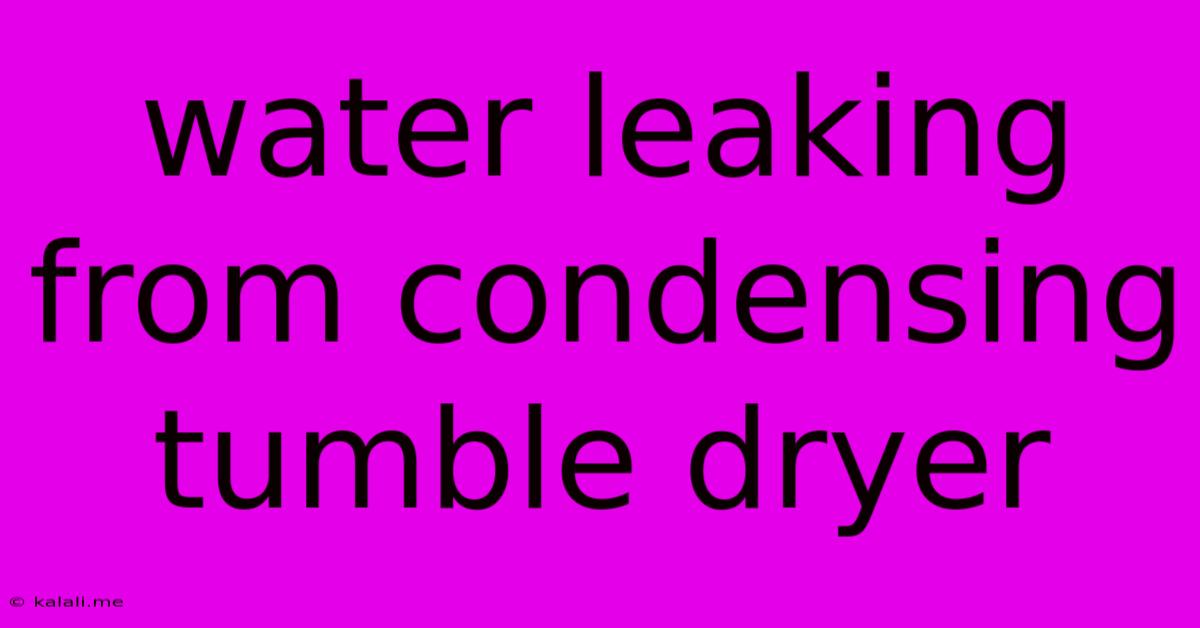Water Leaking From Condensing Tumble Dryer
Kalali
May 22, 2025 · 3 min read

Table of Contents
Water Leaking from Condensing Tumble Dryer: Troubleshooting and Solutions
A leaking condensing tumble dryer can be a frustrating problem, turning laundry day into a plumbing nightmare. This article will guide you through the common causes of leaks in condensing dryers and provide practical solutions to get your machine back in working order. Understanding the source of the leak is key to fixing it quickly and efficiently, preventing further water damage.
Understanding Condensing Dryers and Why They Leak
Unlike vented dryers that exhaust hot, moist air outside, condensing dryers recycle this moisture. They condense the water vapor into liquid water, collecting it in a reservoir or drain hose. A leak indicates a problem within this system. This could be a simple fix or require more advanced troubleshooting, depending on the source of the leakage.
Common Causes of Leaks in Condensing Tumble Dryers
Several factors can contribute to water leaks. Let's explore the most frequent culprits:
-
Blocked Condenser: The condenser is responsible for cooling the moist air and turning it into liquid water. A build-up of lint and dust restricts airflow, reducing efficiency and potentially causing water to overflow. Regular cleaning of the condenser is crucial for preventing leaks.
-
Full Water Tank/Blocked Drain Hose: If your dryer has a water tank, ensure it's emptied regularly. A full tank will inevitably lead to overflow and leakage. Similarly, if your dryer uses a drain hose, check for blockages that could prevent water from draining properly. Inspect the hose for kinks, clogs, or improper connection.
-
Faulty Water Pump: The pump is responsible for moving the condensed water to the tank or drain hose. A malfunctioning pump might not be able to handle the water volume, leading to leaks. A buzzing or unusual noise from the pump could indicate a problem.
-
Damaged Water Tray/Hose: Cracks or holes in the water tank or drain hose will obviously lead to leaks. Carefully examine these components for any visible damage.
-
Loose Connections: Improperly connected hoses or a loose water tank can cause leaks. Check all connections for tightness and ensure proper sealing.
-
Door Seal Issues: While less common, a damaged door seal might allow water to escape from the drum area. Inspect the rubber seal around the door for any damage or wear.
-
Internal Leaks: In rare cases, leaks might originate from internal components, such as a cracked heat exchanger or a faulty water sensor. This usually requires professional repair. Listen for unusual sounds during operation.
Troubleshooting and Fixing Leaks
Before calling a repair technician, try these troubleshooting steps:
-
Clean the condenser: This is the most common solution and often resolves the problem. Consult your dryer's manual for specific instructions on accessing and cleaning the condenser.
-
Empty the water tank/check the drain hose: Make sure the tank is emptied or the drain hose is clear and unobstructed.
-
Check for visible damage: Carefully examine the water tank, drain hose, and door seal for cracks, holes, or loose connections. Replace any damaged components.
-
Inspect the water pump: Listen for unusual noises. If the pump appears faulty, professional repair or replacement is necessary.
-
Check for leaks around the connections: Ensure all hoses are securely connected and tightened.
-
Try a test run: After completing the above steps, run a small load to observe if the leak persists.
Prevention is Key
Preventing leaks is easier than fixing them. Here are some preventative measures:
-
Regular cleaning of the condenser: Clean the condenser at least every 3 months, or more frequently if you use the dryer extensively.
-
Regular emptying of the water tank/monitoring the drain hose: Don't let the tank get full.
-
Visual inspections: Periodically inspect the water tank, drain hose, and door seal for any signs of wear or damage.
By following these steps, you can effectively troubleshoot and resolve most water leaks in your condensing tumble dryer. Remember that for more complex issues, or if you're uncomfortable performing repairs yourself, it’s always best to contact a qualified appliance repair technician.
Latest Posts
Latest Posts
-
Logrotate Failed Sqlnet Log Failed Permission Denied Selinux
May 22, 2025
-
Degree Of Freedom Ssr For 2 Variables
May 22, 2025
-
Add Columns In A File Bc
May 22, 2025
-
Can We Republish Archival Conference Procedings
May 22, 2025
-
How To Find Cos Of Obtuse Angle
May 22, 2025
Related Post
Thank you for visiting our website which covers about Water Leaking From Condensing Tumble Dryer . We hope the information provided has been useful to you. Feel free to contact us if you have any questions or need further assistance. See you next time and don't miss to bookmark.